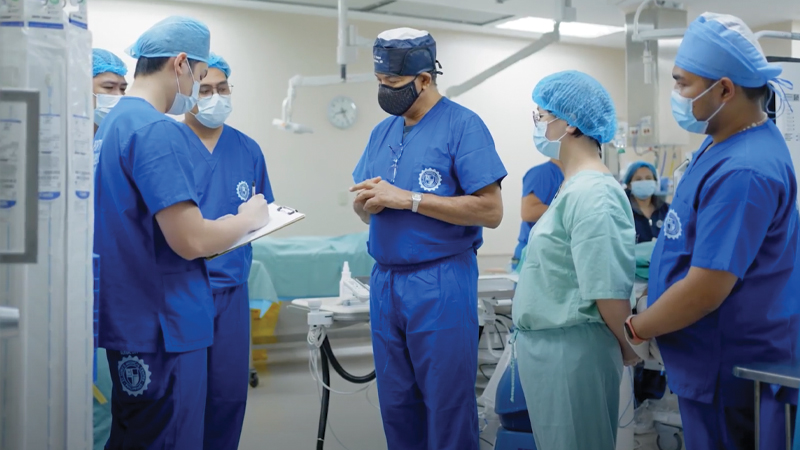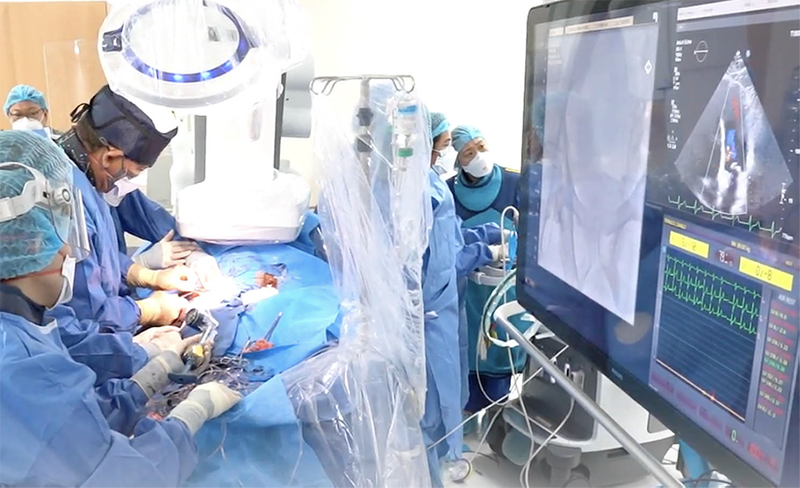St. Luke’s Medical Center celebrates a significant milestone in its cardiac care program: completing 270 Transcatheter Aortic Valve Replacement (TAVR) procedures as of July 2024. This remarkable achievement solidifies the hospital’s position as a pioneer in minimally invasive cardiac interventions in the Philippines.
TAVR is a groundbreaking treatment for patients with severe aortic stenosis, which is due to a severe narrowing of the aortic valve. This eventually restricts blood flow to all major organs. In contrast to an open-heart surgery, TAVR is a far less invasive procedure which is often done via the groin arteries, very often fully percutaneous (no cuts) under mild to moderate sedation and regional femoral nerve blocks to minimize groin discomfort. The transcatheter valve and its delivery system is then advanced back to the heart over specialized wires and is deployed using catheter injections and X-ray for guidance. General anesthesia is seldom required.
Dr. Fabio Enrique Posas, a pioneering interventional cardiologist and head of the Center for Structural Heart and Vascular Interventions (CSHVI) at St. Luke’s – Global City, expressed immense pride in these achievements. St. Luke’s – Global City has performed the most TAVR procedures in the Philippines. “You are as good as the numbers that you do,” Dr. Posas said. TAVR has revolutionized the treatment of aortic stenosis, speeding recovery, and functional improvement while minimizing the scope of interventions. Now approved for all aortic stenosis patient risk profiles, it offers significant advantages for older patients considered at high risk for open-heart surgery. “This milestone reflects our unwavering commitment to providing advanced, minimally invasive treatment options of care under quality controlled environments,” he added.
In addition to pioneering TAVR, St. Luke’s – Global City continues the introduction and expansion of minimally invasive catheter-based technology options of care for mitral valve repair (MITRACLIP), transcatheter tricuspid valve repair (TRICLIP), congenital heart disease, and alcohol septal ablation for the management of hypertrophic obstructive cardiomyopathy (HOCM). All this in conjunction with the expansion of minimally invasive surgical procedures – St. Luke’s Medical Center aims to create and expand the use of effective and minimally invasive options of care for Filipino patients.

The CSHVI boasts a multidisciplinary team of experts, including interventional cardiologists, cardiac surgeons, anesthesiologists, and specialized nursing staff. The hospital’s state-of-the-art catheterization laboratory has the most advanced imaging and surgical technologies to ensure optimal patient outcomes.
Procedural outcomes at the institution are quality controlled and monitored using procedure specific data registries with long term clinical and 2D echocardiogram follow up. “These registries allow us not only to benchmark procedural outcomes but also to assess how our patients do over time,” said Dr. Posas. St. Luke’s TAVR outcomes have been consistently exceptional. Follow up data on the 270 TAVR patients demonstrated a TAVR mortality rate of only 1.48% with an overall procedural success rate of 96.89% in a high risk group of patients. Patients who undergo the procedure at St. Luke’s benefit from experienced multidisciplinary teams of care, optimized facilities of care, shorter hospital stays, faster recovery times, and improved quality of life.
For more information on the TAVR procedure and other structural heart and vascular interventions at St. Luke’s Medical Center, please visit the hospital’s website at www.stlukes.com.ph.




